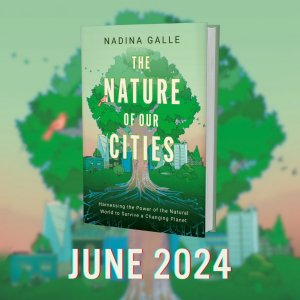
Nadina Galle is an ecological engineer who researches, develops, and brings to market emerging technologies to build better communities for people and nature. Nadina is the host of the Internet of Nature Podcast and her debut book, "The Nature of Our Cities," will be published on June 18.
We spoke to Nadina about her upcoming book, how nature and technology be accessed by community groups and areas where future research is needed.
Hi Nadina! We were excited to find out that you’re publishing your first book. Could you tell us a little bit about the book, what is it about, when did you decide to write it and how has the process been?
"The Nature of Our Cities" explores how cities can blend nature with new technologies to tackle climate change and improve urbanites' health. These are deeply complex and complicated issues, so I wanted to write a non-fiction book that reads like a novel, rich with dialogue, personal anecdotes, and my own journey of self-discovery. What does it mean to be a human living in a city, disconnected from the natural world, in the modern world? Why are natural disasters causing more damage than ever? Why are people more depressed, more anxious, and living shorter lives than generations before us? I decided to write it after noticing how disconnected we've become from nature in cities and realizing we need new ideas. Writing it has been challenging but exciting, involving lots of research and traveling to interview experts around the world. It's been eye-opening to see how tech can safeguard our communities and, if used responsibly and ethically, help us reconnect with nature in urban areas. It's controversial to many, and that's exactly why it excites me so much. The more I learn, the more questions I have.
Are there any key insights city officials or policy makers would get out of reading the nature of our cities?
City officials and policymakers will learn that nature isn't just a nice addition to cities—it's crucial for our health and the environment. The book demonstrates how integrating nature into city planning can enhance urban resilience to climate change and improve people's lives. Importantly, it introduces decision-makers to leaders who have successfully implemented such initiatives and showcases technologies that can accurately calculate the return on investment for nature. It also provides insights on engaging citizens and gaining support across all departments. Ultimately, it serves as a reminder that prioritizing green spaces and nature conservation is essential for constructing better cities.
Which solutions or ideas in the book do you think have the greatest potential for up-scaling?
We've tried for decades to implement changes in cities based purely on good green intentions and sustainability motives. I argue that public health may offer a more compelling argument. One of the most promising aspects highlighted in the book is the utilization of new data sources to pinpoint where nature interventions can have the most significant impact on public health. By harnessing advanced data analytics and mapping techniques, cities can identify areas where access to nature can directly benefit residents' health. This approach resonates strongly with people, as health is often a top priority, making it a powerful tool for garnering support and driving action. By prioritizing health-focused nature interventions supported by data-driven insights, cities can create more compelling arguments for investing in green infrastructure and fostering healthier, more resilient communities.
In researching the book, have you identified any areas where future research is needed?
Expanding on the previous point, effectively prioritizing health-focused nature interventions requires further research into the precise benefits of nature for cities and residents. This research should quantify the positive impacts of green spaces on mental and physical well-being to strengthen arguments for conserving and investing in nature-based solutions. Additionally, future studies must investigate how different communities access and benefit from urban nature to ensure equal distribution of its advantages. By tailoring interventions to meet the specific needs of diverse populations, cities can maximize the benefits of green infrastructure.
How can the symbiosis of nature and technology be accessed by community groups trying to improve their neighborhoods?
Community groups can employ innovative technologies and creative projects to reignite people's connection with nature within their neighborhoods. Initiatives such as Giants of North, utilizing geolocated sound and immersive audio experiences that enable individuals to listen to "talking trees" through a mobile app, demonstrate the potential of technology to foster appreciation and conservation of nature. By leveraging digital tools and actively engaging residents in neighborhood endeavors, communities can not only enhance their surroundings but also cultivate a sense of ownership and stewardship towards local green spaces. This grassroots approach not only contributes to making neighborhoods greener and healthier but also fosters a stronger sense of community cohesion and environmental responsibility.
How can readers find out more and pre-order the nature of our cities?
To learn more about "The Nature of Our Cities" and pre-order, visit nadinagalle.com/the-nature-of-our-cities. Pre-order by June 18th, 2024, to join The Nature of Our Cities Book Club and receive exclusive perks, including a Companion Reading Guide, participation in a Book Club Webinar, and access to a private LinkedIn Group. Simply pre-order from any retailer, email your proof of purchase to nadina@nadinagalle.com, and claim your FREE goodies to delve into the fascinating exploration of urban nature and technology.
